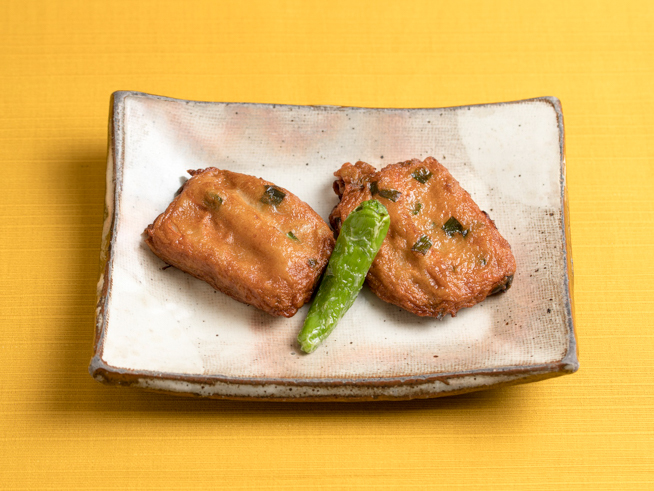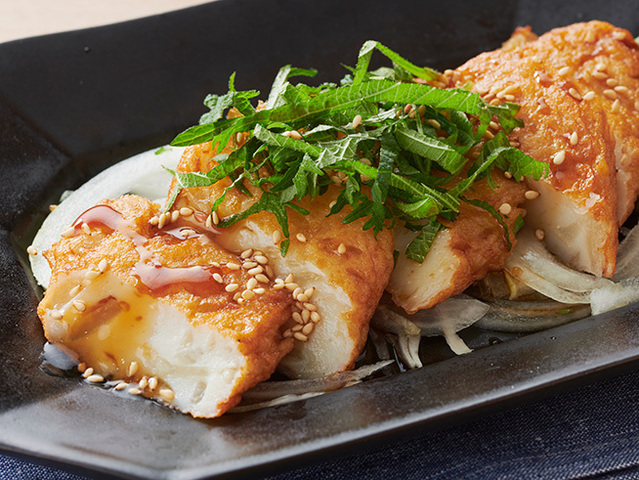
Satsumaage

KagoshimaSatsumaage
Classification (Large)
Seafood products
Classification (Small)
Fishcakes
Main ingredients used
fish paste, tofu, eggs, sugar, local sake (akumochizake)
When using downloaded images, please read the "Terms of Use" and clearly state that the source of the image is "Traditional Foods in Japan" by the Ministry of Agriculture, Forestry and Fisheries.
If the photo credits is stated, please include it as well.
Example of description
of the photo credits
Example of description when the photo credits is not stated
Source: "Traditional Foods in Japan" Ministry of Agriculture, Forestry and Fisheries
Example of description when the photo credits is stated
Source: "Traditional Foods in Japan" Ministry of Agriculture, Forestry and Fisheries
Photo credits:xxx
Region of inheritance
Prefecture-wide
Product overview (special characteristics and types)
Satsuma-age is fish paste with other ingredients added, such as tofu and eggs, before being molded and deep-fried. It is known for being seasoned with sugar for sweetness. The food is also called tsukeage in the Kagoshima region.
History and culture
It is said that satsuma-age was born in the Edo period, when Shimazu Nariakira was the lord of the Satsuma clan. There are various theories related to its origin, with one claiming that inspiration came from the manufacturing methods of Kishu hanpen and kamaboko of the culinary cultures of various clans to create a deep-fried dish with a longer shelf life. Another theory states that the food originated from chikiagi, which is deep-fried fish paste that came over from the Ryukyu area, where trade was thriving at that time in history. It is said that the dish was a means to preserve food such as mackerel and sardines, which were bountiful in those times, and not let them go to waste. There is a theory that the name tsukeage, mentioned in the former passage, evolved from the name chikiagi.
Although satsuma-age was a food to be eaten at events such as New Year’s and during celebrations, in modern times it is a daily soul food for the citizens of Kagoshima.
Production method
Fish is mashed in a mortar or food processer. Drained tofu, eggs, and potato starch are added, and the mix is seasoned with sugar, local sake (akumochizake), and salt before being mashed in a mortar or processed in a food processer once more. When the mixture takes on a smooth and sticky consistency, it is molded and deep-fried. The shapes range from rod-shapes or squares to ovals and round shapes. There is also a variation called chigiri-ten in which the paste is not molded.
A wide variety of fish is used for satsuma-age, such as sardines, mackerel, flying fish, common dolphinfish, slender sprat, and lizardfish. Vegetables are sometimes added as well, including carrots, burdock root, perilla leaves, and lotus root.
Conservation and succession efforts
In 2016, Kagoshima Prefecture established local cuisine representative of the prefecture as the [Taste of Kagoshima], and introduced 28 products (18 products found throughout Kagoshima Prefecture and 10 products from the Amami area), including tsukeage.
Furthermore, Kagoshima Prefecture established manufacturing methods and ingredient standards for foods using traditional manufacturing methods, foods that make the most of the unique qualities of the prefecture’s ingredients, and distinctive foods manufactured through unique technologies. Foods that fit these criteria are certified as [Furusato Certified Foods], and as of the end of March 2023, there are 98 foods certified under satsuma-age.
Main consumption method
Satsuma-age is often eaten as-is, but it can also be used in chirashizushi, simmered dishes, or vinegared dishes. It can be a side dish for meals, or an appetizer with alcoholic beverages.
At-home recipes:Satsuma-age seasoned plainly with ponzu sauce

Ingredients
Satsuma-age
2 pcs.
Onion
1/4 pc
Green perilla leaves
2 leaves
Ponzu sauce
As needed
How to make
Slice satsuma-age diagonally. Cut onion into thin slices and green perilla leaves into thin strips.
Lay the onion slices on a plate, place the satsuma-age slices on them, and sprinkle with the green perilla leaf strips. Pour ponzu sauce over them and serve.

